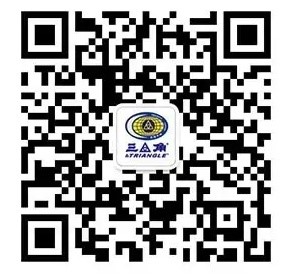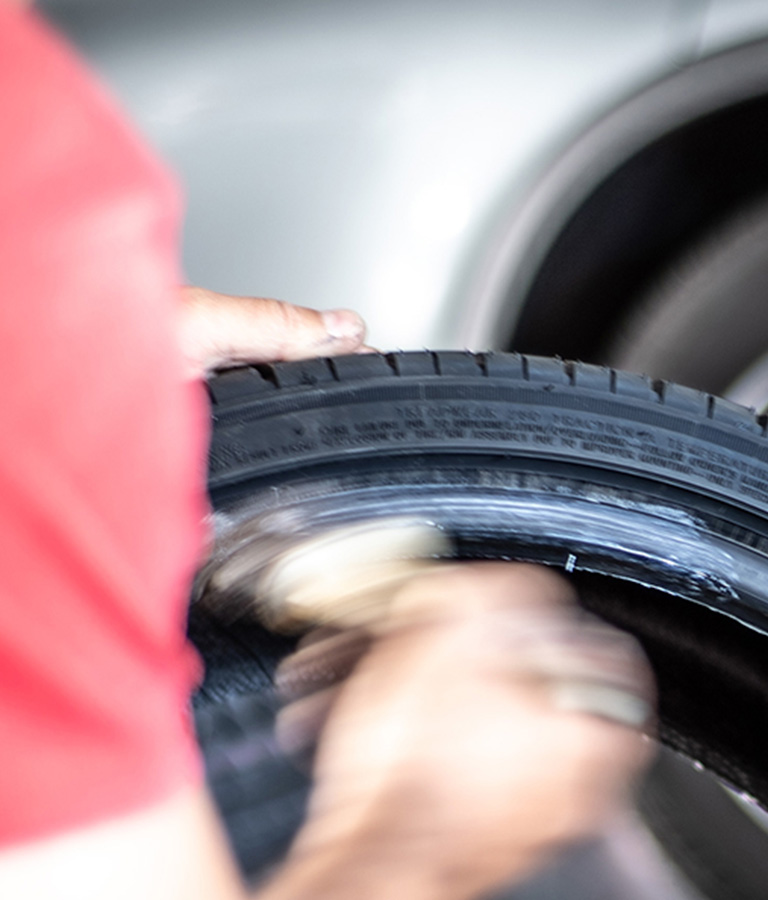
【Inflation of Tires】
· To ensure safety, use the protective cover when inflating the tire.
· New tires should be inflated as per GB standards.
· Before installing a new tire, check the tire cavity for any foreign matters. Tighten the nut of the valve pad to prevent air leakage.
· The air to be filled should be dry and free of moisture and oil.
· The barometer should be accurate and should be periodically inspected.
· After the air under standard pressure is inflated, waif for 15 min before adjusting the air pressure to prevent drops in air temperature and air pressure of the original compressed air.
Position interchanging of tires aims to prevent uneven wear. Generally, such interchanging should be made every 8,000-12,000 km.
In case of long-distance and high-speed driving or summer driving, please check the air pressure frequently and increase the number of stops appropriately. If the air pressure is required to be supplemented, the tire should be cooled first before inflation. If the tire is hot or the internal pressure is high, please stop the vehicle to dissipate the heat. Do not deflate to reduce the pressure or cool the tire with cold water.
· Check the inflating valve for any deformation or leakage.
【Maintenance of Tires】
Level 1 Maintenance
· Check the looseness of the fixing nut, whether the valve mouth is leaking, and whether the valve cap is present
· Check whether the grooves are mixed with debris, whether the tire is delaminated or there're serial faults caused by foreign objects.
· Check whether the tires are appropriately matched, and whether the retainersof the rim are in normal conditions.
· Check the tire air pressure is correct or not.
· Check the conditions of the spare tire.
Level 2 Maintenance
· Disassemble the tire and measure the outer diameter (for position changing and matching)
· Disassemble the tire and rim to check whether the tire is delaminated, whether the bead toe is worn, whether the tire cavity has internal damages, whether the internal tube and tube flap have breakage, whether the inflating valve is intact, whether the rim retainer is deformed. Remove the rust and repaint the tire. Check the bolt holes of the rim for wear, cracks, and remove the debris in the grooves
· The tire should be assembled and inflated properly, do not squat on the tire when it is inflated
· Regularly interchange the positions of the tires
【Tire disassembly】
· Disassembly should be made in clean environment
· Disassemble the tire with dedicated tools
· When disassembling the tubeless tire, the bead toe lubricant should be properly selected to avoid mechanical damage to the bead toe
· The outer and inner liner rims must meet related requirements before assembly
· Ensure that the valve nozzle is aligned with the tire light point mark to reduce the imbalance between the wheel and the tire assembly
· Check whether there’s moisture within the tire
· Tube tire should be favorably inflated twice to avoid mechanical damage to the bead tow; the rims and clamping rings must be perfectly matched
【Features of Various Patterns】
(1) Vertical groove pattern — Excellent handling safety, low resistance to rotation and low noise, excellent drainage performance, resistance to lateral slide.
(2) Horizontal groove pattern — Excellent driving, braking, traction and wear resistance performance.
(3) Mixed pattern — Combined features of vertical groove and horizontal groove patterns.
(4) cross-country pattern — The pattern designed for Dry, wet, rugged mountain roads and muddy, sandy roads.
(5) Directed pattern — The pattern of some tires is directional, which is often called the directional pattern. This pattern mainly addresses the grip performance and drainage performance. And there’re direction marks on the side wall. When installing such tires, installation should be made along the rolling direction of the tire.
【Inspection Process of Departure in Driving】

【Use and maintenance of tires】
I.Storage
1. Tires should be stored in the warehouse to avoid direct sunlight and rain.
2. Tires should be kept away from heat sources, power generation equipment and places where ozone is generated.
3. Tires should not be mixed with oil, flammable materials and chemically corrosive materials.
4. Tires should be placed vertically and should not be placed horizontally, stacked or hung concentrically.
5. The tires should be used in an FIFO manner according to the production and warehousing time, and the storage period should not exceed three years.
II. Air Pressure
1.The tire should be inflated according to the air pressure load comparison table specified in the national standard.
2. After the tire is inflated, check all parts for leaks. If leaks are found, repair it immediately.
3. During the use of the tire, the internal pressure must be normal. When running or operating for a long time, the tire pressure should be checked regularly. When the tire is stopped for a long time, the front and rear axles must be raised.
4. In case of air pressure of the hire, the tire crown would be easily worn or burst at the top. And in case of low air pressure, tire shoulders would easily be worn or deformed or subject to damages of crushing.
5. When two tires are installed at the same time, the inflation of the two tires should be the same. And it is prohibited to have one tire with high air pressure while the other with low air temperature.
III. Speed
1. Various tires are subject to different speed levels, and overspeed driving would cause early damage to the tires.
2. When the road is not good, don't drive too fast and try to minimize sharp braking and sharp turns as possible.
3. The tire is easy to heat up at high speed. Once the temperature is too high, measures should be taken in time to prevent the carcass from bursting.
4. High speed tire and rim assembly must be checked for dynamic balance, counterweight and correction.crown would be easily worn or burst at the top. And in case of low air pressure, tire shoulders would easily be worn or deformed or subject to damages of crushing.
5. When two tires are installed at the same time, the inflation of the two tires should be the same. And it is prohibited to have one tire with high air pressure while the other with low air temperature.
IV. Pattern
1. The vertical pattern has small resistance and high speed, and is suitable for hard pavements such as cement and asphalt.
2. The horizontal pattern has strong grip, good climbing performance, and can adapt to the current features of pavements in China.
3. The mixed pattern combines the features of horizontal and vertical patterns.
4. Cross-country pattern is suitable for roads with no pavements or only poor conditions.
5. When the tread pattern is worn to the wear mark, it should not be used any longer.
V. Load
1. The tire load should satisfy the load specified in the current national standards, and overload should be strictly prohibited.
2. Cargo loads should be distributed evenly to avoid unbalanced loads.
3. Serious overload would result in abnormal wear of tire tread, empty shoulders, delamination, bead toe blasting, etc.
4. High-level and heavy-load tires are not suitable for high-speed driving.
5. The load of reinforced tire may be appropriately increased the load according to design standards.
ubject to damages of crushing.
VI. Assembly
1. Tires must be assembled on the prescribed vehicle models and rims. Special tools and equipment shall be required to install and remove the tires. It is strictly prohibited to pry or smash them in a forcible manner.
2. The same axle should be equipped with tires of the same size, structure, pattern and tier level.
3. Bias tires and radial tires should not be mixed.
4. When equipped with the patterned tire, the tire rotation direction mark should be consistent with the driving direction of the vehicle.
5. The off-the-road tires and tubeless tires should be assembled and disassembled in accordance with related regulations.
6. Tires equipped with snow chains should be installed in a symmetrical manner and the snow chains should be removed immediately when they’re not in use.
VII. Inner Tube
1. Match the corresponding inner tube according to the tire size.
2. In case of air leakage of inner tube, it will cause early damage to the outer tube.
3. Butyl rubber inner tube has excellent temperature resistance and air tightness performance. And High-speed tires should be equipped with butyl rubber inner tubes.
4. If the inner tube is required to be stored separately, it should be inflated with an appropriate amount of air, and it should not be laid horizontally or folded. If it is not stored separately, it should t be placed in the outer tube and inflated appropriately.
VIII. Twin Tire Management
The difference in the outer diameter of the twin tires should be minimized. If the outer diameter is different, the smaller outer diameter should be installed inside.
IX. Position Interchanging
1. The positions of the tires should be interchanged periodically.
2. For passenger car vehicles, generally the position interchanging should be made every 8,000 km.
3. Truck tires and off-the-road tires are to be maintained with Level 1 maintenance, the Level 1 maintenance should be made. If necessary (such as severe unilateral wear), a position interchanging should be performed to keep the wear of the tread pattern uniformly; if the tire is to be maintained with the Level II maintenance of the vehicle, Level II maintenance of the tire should be conducted. Problems found in the maintenance, if any, should be recorded and disposed in a timely manner.
4. Industrial and mining tires should have their positions interchanged (left-and-right) at fixed time intervals.
ed with snow chains should be installed in a symmetrical manner and the snow chains should be removed immediately when they’re not in use.
Share to






Copyright © 2019 - 2020 Triangle Tyre Co., Ltd 沪ICP备14019152号-1  沪公网安备 31019002000242号 All rights reserved Powered by Yongsy
沪公网安备 31019002000242号 All rights reserved Powered by Yongsy




 DE
DE ES
ES FR
FR IT
IT US
US РФ
РФ




